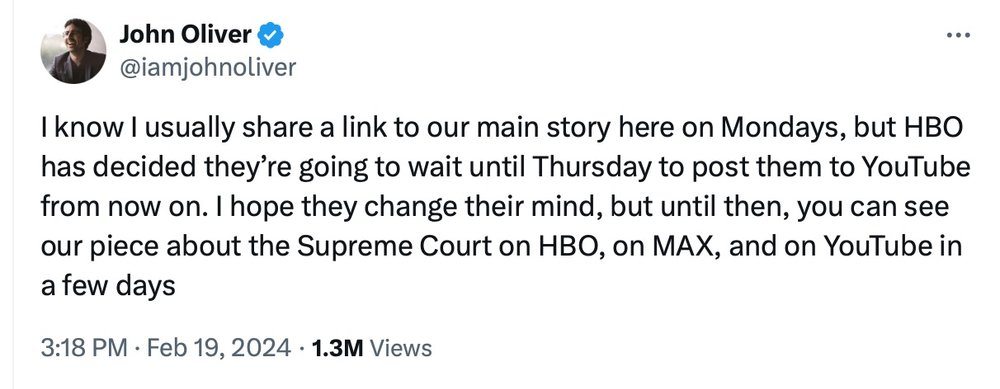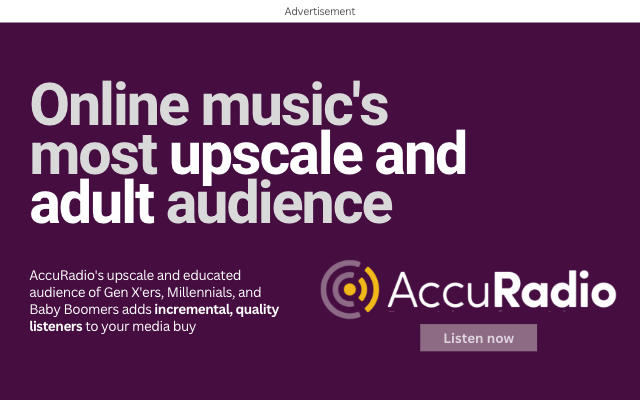
Steve Goldstein’s Amplifi Media works with media companies and podcasters in developing audio content strategies. Goldstein writes frequently at the Amplifi blog. Steve can be reached directly at 203-221-1400 or sjgoldstein-at-amplifimedia-dot-com.
 In the ever-evolving landscape of digital content, the axiom “follow the audience” has never been more pertinent. HBO made a strategic shift this week by opting to delay posting YouTube clips of John Oliver’s Sunday night show “Last Week Tonight” from Mondays to Thursdays. This change spotlights a crucial aspect of content distribution and engagement. The decision aims to drive viewership on HBO’s streaming platform, Max, by converting YouTube viewers into paying subscribers. At a glance, the logic is clear, given the platform’s subscription fee of $15 per month.
In the ever-evolving landscape of digital content, the axiom “follow the audience” has never been more pertinent. HBO made a strategic shift this week by opting to delay posting YouTube clips of John Oliver’s Sunday night show “Last Week Tonight” from Mondays to Thursdays. This change spotlights a crucial aspect of content distribution and engagement. The decision aims to drive viewership on HBO’s streaming platform, Max, by converting YouTube viewers into paying subscribers. At a glance, the logic is clear, given the platform’s subscription fee of $15 per month.
Maybe this will work, but more likely, it’s too late.
The question is whether people will “wait and see” or “pay to see.” Or neither.
One way or another, this move ignites a debate on the efficacy and importance of timing and accessibility in content strategy.
Is Thursday too late?
With over 9 million subscribers on its YouTube channel and millions of views per clip, “Last Week Tonight with John Oliver” underscores the immense potential of social media clips as a tool for audience engagement, expansion, and monetization. As we have discussed before in our Thought Letter, the immediacy with which clips from broadcast shows are shared and consumed is particularly evident in the case of late-night talk shows or “Saturday Night Live,” where content is posted within 24 hours of airing. This digital currency plays a significant role in maintaining a show’s relevance and reach – especially with younger demographics. These clips are not just additional content; they are a crucial economic asset, often surpassing the viewership of the original broadcasts. Oliver’s show has about 400,000 viewers on HBO and millions more online.
The reaction from John Oliver himself is pretty telling, expressing concern over the decision’s impact on the show’s social media footprint:

What does this have to do with podcasting?
As platforms and preferences shift, the essence of “heat”—the instant, viral potential of content—remains a constant. The timing of releases, platform choice, and accessibility are not mere logistical decisions; they are integral to the visibility and often the success of content.
The heat of the moment, can be the difference between a podcast listen and a show stuck in the purgatory of the podcast queue. People often choose what is hot and buzzy right now.
The importance of social media clips as a conduit for audience connection, content discovery, and brand amplification cannot be overstated.
The case of “Last Week Tonight” is a compelling illustration of the challenges and opportunities that lie in balancing platform-specific business strategies with the goal of maximizing audience engagement. In this case, there are two really big issues – the audience on YouTube is younger and may not be willing to fork over $15 a month, and the bigger issue – comedy, in particular, is all about timing. What’s hot Monday may not make the grade on Thursday.
The heat of the moment, can be the difference between a podcast listen and a show stuck in the purgatory of the podcast queue.
People often choose what is hot and buzzy right now. Podcasters and aggregators have been grappling with exclusive content on a single podcast platform, “windowing” exclusive content for a period of time and subscription paywalls. All of this seems to be crumbling, whether it is Joe Rogan or Alex Copper ‘s“Call Her Daddy” opting for wider distribution or unlocking subscriptions to garner more listeners.
It’s all part of the same undeniable arc of putting the audience first and making content easy to find and play.
Harnessing the heat of the moment to foster engagement, expand reach, and ultimately drive success in the digital ecosystem is evolving rapidly.
For podcasters, we continue to recommend thinking beyond the RSS feed and developing bespoke strategies to reach your audience where they are at — and on their timeline.
Heat matters.

